





PHOTO GALLERY

Photos by Len Blumin
1. Wrentit
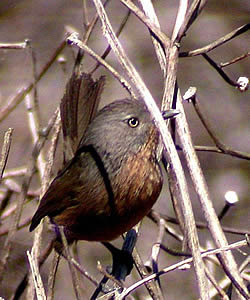
Forgive me if I "babble" a bit about the Wrentit (Chamaea fasciata). Hikers in coastal scrub or chaparral in California are very familiar with the bouncing ball song, but rarely do we see one pop up to check us out. Even then it's usually for a quick look and then back down in the brush.
The Wrentit has a charming and perhaps old-fashioned lifesytle, spending their whole lives in a monogamous relationship and never traveling from their chosen territory, which might be only 2-3 acres. The birds are devoted to each other, staying close as they forage, mutually preening, and even "roost together, leaning against each other on (a) limb near (the) crown of a bush with feathers interlaced and inner legs drawn up, appearing as one ball of feathers." [Audubon Soc. Encycl. of NA Birds]. We saw both members of the pair, which can be distinguished by song, with the male's ending with a pretty trill. They were in marshside brush along the Bahia property, preserved by Marin Audubon Society and others, and now part of Marin Open Space.
Note the cocked up tail, like a wren's, and the light-colored iris. Rufous color of the underparts perhaps accentuated by photoprocessing.
The Birder's Handbook (Erlich et.al.) has an interesting piece on how taxonomists have stuggled to classify the Wrentit, which seems to have no relative in the Western Hemisphere. It is clearly not a wren, and not even a "tit" (British term for small birds like titmice and bushtits). Current thinking, based on DNA studies, places the Wrentit in the Old World Babbler family (Sibley Guide Bird Behavior). Ok, done babblin.
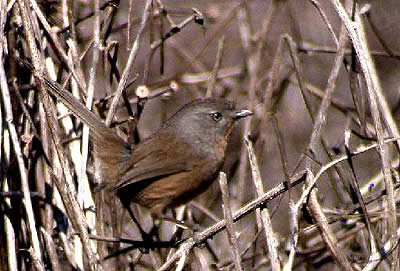
A nature photographer quickly learns to accept the fact that many shots will be less than perfect, especially with a moving target. Sometimes a little blurriness is acceptable, especially if the shot demonstrates an important feature, as in this shot of the Wrentit (Chamaea fasciata), which nicely shows the cocked-up tail that led early naturalists to place him in the wren family.
Note the short wings, which they don't use very much, as they spend most of their time deep in the bushes hopping from branch to branch. Flights are short, as they spend most of their life in the territory they settle in, eating insects, berries and just about anything edible. In captivity they will eat bananas, cottage cheese, boiled eggs and grapes!
2. "I Wish that I Could be a California Gull"
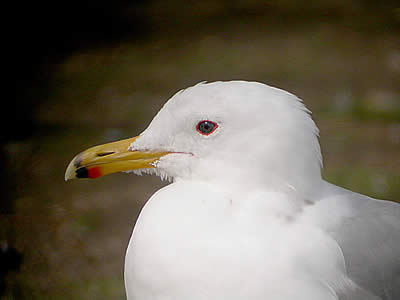
California Gull - Larus californicus. We watched a large group of them at the south end of Lake Merced, near the bridge. Leg colors varied from dull gray to a fairly bright yellow. This one seemed to be in full breeding plumage, with a gorgeous red orbital ring and both red and black spots on the end of the bill. Dark gray back, but not as dark as the Western Gull. Also note the dark iris. I heard once that 50% of all the California Gulls in the world breed on the Farralone Islands.
3. Greater Scaup
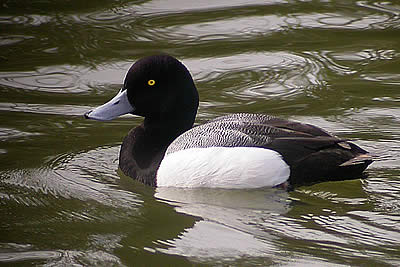
A common sight on San Francisco Bay and elsewhere on the west coast, Scaup are sometimes seen in rafts of hundreds, even thousands. White flank, gray back, black head, gray bill. Not very colorful. But as in his Aythya cousins, there are subtle features present that are seen best with a closer view, as this male Greater Scaup (Aythya marila) demonstrates. Taken 23 March 2006 at the south end of Lake Merced. Note the fine barring on the back, large bill with good sized black "nail" on the end, and a nicely rounded head. Perhaps not as comely as his cousin the Ring-necked Duck, present in great numbers nearby, but an elegant duck none-the-less.
4. Double-crested Cormorant
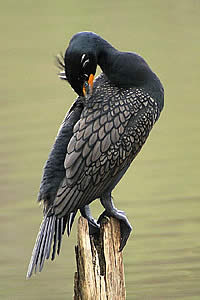
I must admit I've always thought of cormorants as "black birds with long hooked bills, and in learning to identify the various species (5 in the lower 48 states) I focus on structural features like tail, neck, and bill. But as Rich S pointed out, the back feathers are anything but a simple black, and illustrate the complex beautiful patterns of the various feather groups. Most of what we see are the protective feathers, or "coverts", in a shingled design worthy of a Victorian cottage.
Double-crested Cormorant (Phalacrocorax auritus). Taken with new camera, Nikon Coolpix 8400 (and spotting scope), at Rodeo Lagoon, April 9, 2006.
5. Horned Grebe
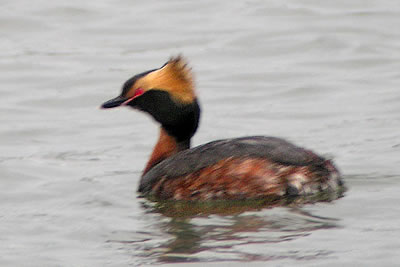
The Horned Grebe (Podiceps auritus) is drab during most of the year, except for its brilliant red-orange eye. In April they undergo a rather spectacular molt from their basic dark gray/white plumage into their colorful alternate or "breeding" plumage. All too soon they leave for breeding grounds in Canada, but there are still a few around to dazzle us, like this one on Bolinas Lagoon today.
The fluffed golden-wheat colored "horns" defy the rigors of frequent dives. The dark rufous neck clearly differentiates the Horned Grebe from his cousin, the Eared Grebe (Podiceps nigricollis), who has a black neck, and in fact is known as the Black-necked Grebe in Europe, as you might guess from the Latin name. Just to confuse things, you have probably already noted that the Horned Grebe's name, P. auritius, literally means "eared grebe". Go figure. I know, "Rufous-necked Grebe" would have been better than "Horned", but I'm sure the wise folks who chose the names had their reasons. (Yeah, right....)
Photo notes: Taken with Swarovski 80HD, 30x SW eyepiece, Nikon Coolpix 8400, f4, 1/127 sec. exposure. Bird was about 100 feet away, and the photo shown is a crop of a shot 300% larger.
TOWHEE.NET: Harry Fuller, 820 NW 19th Street, McMinnville, OR 97128
website@towhee.net